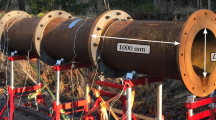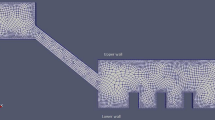Abstract
Transom wave behind planing hulls is a complicated physical phenomenon that has lead to computational challenge for many researchers. On the other hand, smoothed particle hydrodynamics (SPH) which is known as a meshless Lagrangian approach can simulate free surface flows with strongly nonlinear physics. Therefore, effort has been made in the current study to develop a 3D-SPH code for three-dimensional simulation of transom stern flow behind a rectangular planing hull. It is also aimed to give some new physical insights into this highly nonlinear problem. Different techniques such as sub particle scale turbulence model and moving least square density filter among others are also implemented. To validate the developed 3D-SPH code, the benchmark problem of dam breaking is investigated. Moreover, to verify the capability of the presented SPH model for transom flow simulation, previous experimental studies at low Froude numbers are considered. Comparisons display good agreement between the numerical results and experimental findings. Furthermore, a detailed discussion about rooster tail formation is presented.































Similar content being viewed by others
References
O’Dea J, Jenkins D, Nagle T (1981) Flow characteristic of a transom stern ship. David W. Taylor Naval Ship Research and Development Center
Robards S, Doctors JL (2003) Transom-hollow prediction for high-speed displacement vessels. In: Proceedings of seventh international conference on Fast Sea Transportation (FAST’03), Ischia, Italy, vol 1, pp A1.19–A1.26
Doctors J (2003) Hydrodynamic of the flow behind a transom stern. In: Proceedings of the 29th Israel conference on mechanical engineering, Haifa
Doctors J (2006) Influence of the transom-hollow length on wave resistance. In: Proceedings of twenty-first international workshop on water waves and floating bodies (21 IWWWFB), Loughborough, England
Fu T, Karion A, Pence A, Rice J, Walker D, Ratcliffe T (2005) Characterization of the steady wave field of the high speed transom stern ship—Model 5365 Hull Form, Carderock Division, Naval Surface Warfare Center, Hydromechanics Department Report
Maki JK, Troesch A, Beck R (2005) Qualitative investigation of transom stern flow ventilation. In: Proceedings of 19th international workshop on water waves and floating bodies, Cortona, Italy
Yamano T, Ikebuchi T, Funeno I (2001) Stern waves consisting of forward oriented breaking waves and the remaining following waves. J Mar Sci Technol 6:13–22
Yamano T, Kusunoki Y, Kuratani F, Ogawa T, Ikebuchi T, Funeno I (2002) A method to confirm scale effect of stern waves due to a transom stern. J Kansai Soc Nav Archit Japan 237
Maki JK, Doctors JL, Beck R, Troesch A (2005) Transom-stern flow for high-speed craft. In: 8th international conference on fast sea transportation, Saint Petersburg, Russia
Fu T, Fullerton A, Ratcliffe T, Minnick L, Walker D, Pence M, Anderson K (2009) A detailed study of transom breaking waves. Carderock Division, Naval Surface Warfare Center, Hydromechanics Department Report
Fu T, Fullerton A, Drazen D, Minnick L, Walker D, Ratcliffe T, Russell L, Capitain M (2010) A detailed study of transom breaking waves: Part II. Carderock Division, Naval Surface Warfare Center, Hydromechanics Department Report
Savitsky D, Morabito M (2009) Surface wave contours associated with the forebody wake of stepped planing hulls. In: Meeting of the New York Metropolitan Section of the Society of Naval Architects and Marine Engineers
Haussling HJ, Miller RW, Coleman RM (1997) Computation of high speed turbulent flow about a ship model with a transom stern. Carderock Division, Naval Surface Warfare Center, Hydromechanics Department Report
Tahara Y, Iwasaki Y (1997) A study of transom stern free surface flow by 2D computational and experimental models. J Kansai Soc Nav Archit Japan 227
Schweighofer J (2005) Investigation of two-dimensional transom waves using inviscid and viscous free-surface boundary conditions at model- and full-scale ship reynolds numbers. In: 5th numerical towing tank symposium, Pornichet, France
Starke B, Ravan H, Van Der Ploeg A (2007) Computation of transom-stern flows using a steady free-surface fitting RANS method. In: 9th international conference on numerical ship hydrodynamics, Michigan
Maki K, Iafrati A, Rhee S, Beck R, Troesch A (2006) The transom-stern modeled as a backward facing step. In: 26th symposium on naval hydrodynamics, Rome, Italy
Robert W, Carrica PM (2006) URANS simulations for a high-speed transom stern ship with breaking waves. Int J Comput Fluid Dyn 20(2):105–125
Ohashi K, Hasegawa J, Fukasawa R (2008) Numerical simulation of high speed ship wash waves. In: 6th International conference on high-performance marine vehicles, Naples (Italy) 18th–19th September
APS division of fluid dynamics gallery of fluid motion. http://hdl.handle.net/1813/17527. Accessed 23 Nov 2010
Drazen DA, Fullerton AM, Fu TC, Beale KL, O’Shea TT, Brucker KA, Wyatt DC, Bhushan S, Carrica PM, Stern F (2010) Comparisons of model-scale experimental measurements and computational predictions for the transom wave of a large-scale transom model. In: Proceedings of the 28th symposium on naval hydrodynamics, Pasadena, CA, USA
Dommermuth DG, Schlageter E A, Talcott JC, Wyatt DC, Novikov EA (1997) Numerical simulation of bow waves and transom-stern flows. American Physical Society, Division of Fluid Dynamics Meeting, November 23–25
Landrini M, Colagrossi A, Tulin MP (2001) Breaking bow and stern waves: numerical simulations. In: Proceedings of 16th international workshop on water waves and floating bodies, Hiroshima, Japan
Marrone S, Colagrossi A, Antuono M, Lugni C, Tulin MP (2011) A 2D + t SPH model to study the breaking wave pattern generated by fast ships. J Fluids Struct 27:1199–1215
Lucy L (1977) A numerical approach to the fission hypothesis. Astron J 82–1013
Gingold RA, Monaghan JJ (1977) Smoothed particle hydrodynamics: theory and application to non-spherical stars. Mon Not Roy Astron Soc181–375
Monaghan JJ (1990) Simulating free surface flows with SPH. J Comput Phys 110:399–406
Monaghan JJ (2005) Smoothed particle hydrodynamics. Rep Prog Phys 68:1703–1759
Cleary PW, Prakash M, Ha J, Stokes N, Scott C (2007) Smooth particle hydrodynamics: status and future potential. Prog Comput Fluid Dyn 7:25–76
Liu MB, Liu GR (2010) Smoothed particle hydrodynamics (SPH): an overview and recent developments. Arch Comput Methods Eng 17(1):25–76
Gotoh H, Shibihara T, Hayashi M (2001) Subparticle-scale model for the mps method lagrangian flow model for hydraulic engineering. Comput Fluid Dyn J 9(4):339–347
Issa R (2004) Numerical assessment of the smoothed particle hydrodynamics grid-less method for incompressible flows and its extension to turbulent flows. PhD thesis, University of Manchester Institute of Science and Technology (UMIST)
Crespo A (2008) Application of smoothed particle hydrodynamics model SPHysics to free surface hydrodynamics. Doctoral thesis
Liu GR, Liu MB (2007) Smoothed particle hydrodynamics—a meshfree particle methods. World Scientific, Singapore
Dalrymple RA, Rogers B (2006) Numerical modeling of water waves with the SPH method. Coast Eng 53:141–147
Dilts GA (1999) Moving-leastsquares-particle hydrodynamics I. consistency and stability. Int J Numer Methods Eng 44:1115–1155
Colagrossi A, Landrini M (2003) Numerical simulation of interfacial flows by smoothed particle hydrodynamics. J Comput Phys 191:448–475
Shao S, Gotoh H (2004) Simulating coupled motion of progressive wave and floating curtain wall by SPH-LES model. Coast Eng J 46(2):171–202
Dalrymple RA, Knio O (2000) SPH modelling of water waves. In: Proceedings of coastal dynamics, Lund
Monaghan JJ (1994) Simulating free surface flows with SPH. J Comput Phys 110:399–406
Kleefsman KMT, Fekken G, Veldman AEP, Iwanowski B, Buchner B (2005) A volume of fluid based simulation method for wave impact problems. J Comput Phys 206:363–393
Savitsky D, Brown PW (1976) Procedures for hydrodynamic evaluation of planing hulls in smooth and rough water. Mar Technol
Author information
Authors and Affiliations
Corresponding author
Additional information
Technical Editor: Francisco Ricardo Cunha.
Rights and permissions
About this article
Cite this article
Dashtimanesh, A., Ghadimi, P. A three-dimensional SPH model for detailed study of free surface deformation, just behind a rectangular planing hull. J Braz. Soc. Mech. Sci. Eng. 35, 369–380 (2013). https://doi.org/10.1007/s40430-013-0035-9
Received:
Accepted:
Published:
Issue Date:
DOI: https://doi.org/10.1007/s40430-013-0035-9




